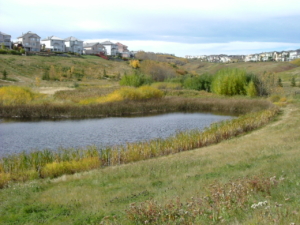SuDS assessment: What do we need to know?
Is a SuDS assessment compulsory?
In certain situations, a Sustainable Urban Drainage Systems (SuDS) assessment is a compulsory requirement. In England, from the 6th April 2015, it became compulsory for SuDS to be considered in planning applications for major developments.
In Wales, it is now a mandatory requirement for any construction work which has drainage implications not to commence until a SuDS system has been approved by a SuDS Approval Body (‘SAB’). The construction work relates to all new developments of more than 1 house or where the construction area is 100m2 or more.
In many instances, SuDS can be implemented and integrated into a development easily and at a lower cost than traditional drainage systems, particularly where SuDS and drainage are considered early within the development lifespan. SuDS have a wide of range of benefits including flood risk reduction on-site and elsewhere, improving water quality, biodiversity and improving the amenity value to occupants/users of the development.
If SuDS cannot be implemented on Site, then architects and planning consultants need to provide a robust argument and reasons to demonstrate why SuDS are not appropriate. The reasons may include spatial constraints associated with the development layout, planning constraints, or constraints associated with environmental conditions such as historic contamination or flood risk. SuDS can on the whole be included on most developments, as long as they are considered as early as possible in the development process.

What is the purpose of a SuDS assessment?
The SuDS assessment forms part of the flood risk management plan and aims to manage surface water and thereby prevent flooding in new developments.
When might a developer choose to have a SuDS assessment?
- Validating planning applications at Pre-Planning Stage;
- Planning Conditions;
- Building and flood mitigation design;
- Due diligence;
- Code for Sustainable Homes;
- SuDS approval bodies (SABs) currently in Wales; and
- Lending, mortgages, and pension funds.
In England, what is the most common situation for a SuDS assessment to be needed?
The most common situation for when a SuDS assessment is required is when a local authority has included a planning condition referencing drainage.
What are planning conditions?
When a planning application is granted, the local authority will insist certain conditions are met. Conditions can include prior approval relating to external building materials, completion time (usually three years), ecology mitigation matters, tree protection measures and/or drainage.
What is the typical wording of a planning condition which suggests a SuDS assessment is required?
The wording would be similar to the following:
“No development above ground level shall take place until details of the sustainable drainage measures to manage surface water within the site, including the drainage field for the package treatment plant, have been submitted to and approved in writing by the Local Planning Authority.”
The planning condition will then list specific requirements relating to the condition – here are a few examples:
“Incorporate the implementation of Sustainable Drainage methods (SuDS) in accordance with
the Non-Statutory Technical Standards for SuDS (March 2015), the SuDS Manual C753 (2015) and Council local standards” – This is standard guidance for all SuDS assessments.
“Include and be informed by a ground investigation survey which establishes the soil
characteristics, infiltration rate and groundwater levels”. This would require a consultant visiting the site and conducting an infiltration test (soakaway test).
“Include attenuation measures to retain rainfall run-off within the site, off site discharge will not be permitted” – This refers to how rainwater is stored and would be included in SuDS reports.
“Include construction drawings, cross-sections and specifications of all proposed SuDS
measures within the site” – This means that detailed drawings would be required following the initial strategy being produced.
“Include run-off calculations, discharge rates, infiltration and storage capacity calculations for the proposed SuDS measures based on a 1 in 100 year storm +40% for climate change” – These calculations would be included in SuDS reports.
“Include pre-treatment methods to prevent any pollution or silt entering SuDS features or
causing any contamination to the soil or groundwater” – This is where a report would need to consider pollution such as oil – this would be included in a SuDS report.
“Ensure any permeable paved areas are designed and constructed in accordance with
manufacturers guidelines” – This means that you will need to liaise with your building contractor to ensure the correct materials are used.
“Ensure any permeable areas are constructed on a permeable sub-base material such as Type3 or reduced fines Type 1 material as appropriate” – This means that you will need to liaise with your building contractor to ensure the correct materials are used.
“Include details of how the SuDS measures will be maintained and managed after completion”. These details shall be provided as part of a handover pack for subsequent purchasers and owners of the property/premises.” – This is referred to in a SuDS report but GeoSmart can also provide a Management and Maintenance Plan at an additional cost.
What does “discharging” a planning condition mean?
If a condition is “discharged” then the planning condition is met. For a condition relating to SuDS, the condition will be discharged when the council has approved the SuDS assessment and has confirmed that all drainage requirements have been met.
Are there any costs involved to discharge a condition?
Yes, a condition attached to a householder application is £34. For a new single dwelling the fee is £116. Therefore, it makes economic sense to request approval of all conditions on one single form.
Can I appeal a planning condition?
Yes, if you feel the condition is unfair, unlawful or unreasonable. The appeal process is the same as the planning appeal process and can take up to six months.
How do I know which type of SuDS assessment is required for my project?
There are varying levels of reports for planning applications and for a condition to be discharged. These can be based upon whether the development is defined as minor or major, the type of planning application (i.e. outline, full or reserved matters) and depending on the region and Council within the UK.
A SuDS assessment for a minor application, for example, would need to include a drainage strategy including a schematic (mapping of the drainage system) which is based upon a feasibility assessment of the site. This is normally informed by, or followed by, a Site Investigation to confirm the underlying ground conditions or confirmation from the Risk Management Authority (RMA) such as the Environment Agency or utility provider that the water feature or sewer has sufficient capacity. A detailed design including modelling of the drainage network is normally required once the SuDS strategy has been accepted in principle or conditioned.
For due diligence and an initial feasibility review, a SuDS report which includes data on geology would be sufficient.
How long does it take for a SuDS assessment to be completed?
Usually, a SuDS assessment with a drainage strategy/schematic would be completed within 15 working days. It takes 5 working days to receive the sewer data required to complete the report. However, GeoSmart can produce an assessment sooner where this is requested.
Would a SuDS consultant need to visit the site?
No, the SuDS assessment can be completed from data available. It would be unusual for a consultant to be required to visit the site, however, some conditions will stipulate an infiltration test being carried out which would involve visiting the site.
Why is it prudent to have a SuDS assessment as part of a due diligence exercise?
An initial review would allow for considerations of what drainage system would be most beneficial. From a cost perspective, infiltration into the ground is the ideal, but some sites will require more costs if discharge into sewers is required. Remember, the earlier SuDS are considered as part of the development, the lower the costs and the more likely SuDS will be feasible.
Will the council require more work after the SuDS assessment is submitted?
We have an excellent understanding of UK local authrority requirements in relation to drainage conditions. Some require more detail than others at the planning approval stage. We conduct a free review of your planning condition and we will advise on the best course of action for your project.
Why use SuDS over traditional drainage?
SuDS are more sustainable than traditional site drainage methods as they:
- Manage runoff volumes and flow rates from hard surfaces, reducing the impact of urbanisation on flooding;
- Provide opportunities for using runoff where it falls;
- Protect or enhance water quality (reducing pollution from runoff);
- Protect natural flow regimes in watercourses;
- Are sympathetic to the environment and the needs of the local community;
- Provide an attractive habitat for wildlife in an urban watercourse;
- Provide opportunities for evapotranspiration from vegetation and surface water;
- Encourage natural groundwater/aquifer recharge (where appropriate);
- Create better places to live, work and play.
For more information about our SuDS reports or to speak to a SuDS consultant, please call us on 01743 581415 or email enquiries@geosmartinfo.co.uk.



